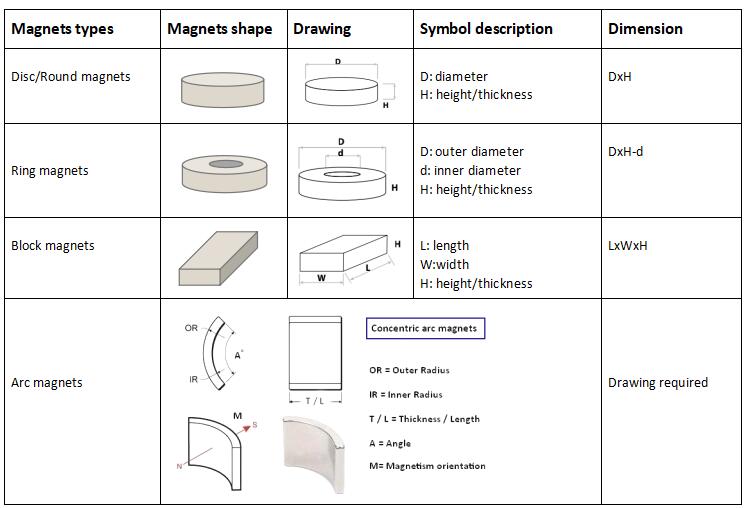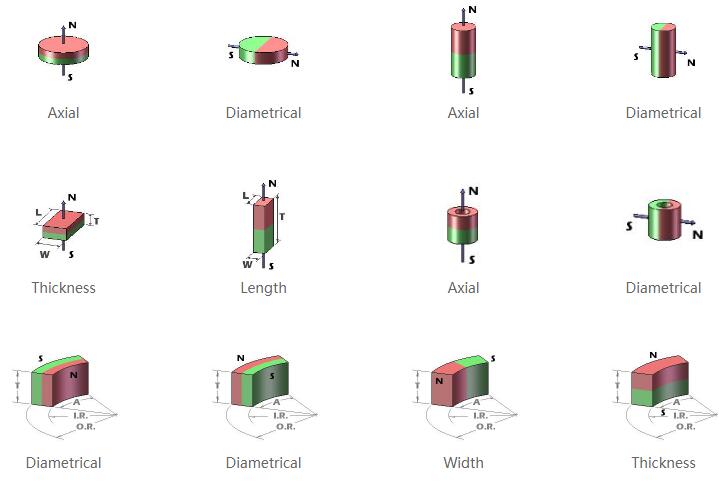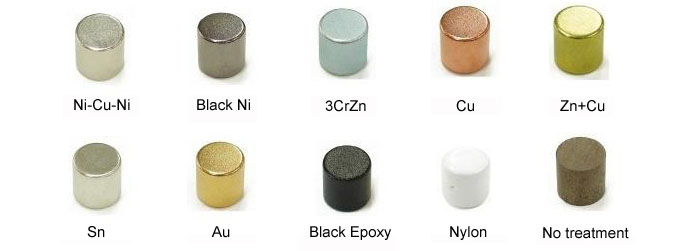
7 Important Factors to Consider When Customizing Magnets
If you need a magnet of a special shape and size, a custom magnet is required. If you want your custom magnet to fit perfectly into your project, there are several important factors to consider.
| 7 Important Factors to Consider When Customizing Magnets |
1. How to choose a magnet material?
There are several types of magnetic materials, depending on the value you want to get from your product or how you want to use it decide which material you need to customize your magnet.
1. NdFeB (NdFeB): NdFeB is divided into sintered NdFeB and bonded NdFeB, the most widely used in the market is sintered NdFeB. Neodymium magnets also have various uses, such as neodymium tile magnets, neodymium ring magnets and neodymium cylinder magnets, especially for the manufacture of motor magnets.
2. Samarium cobalt (SmCo): The value of samarium cobalt magnet is relatively high, high temperature resistance, corrosion resistance, generally do not do coating treatment, the important characteristic of samarium cobalt magnet is high temperature resistance.
3. AlNiCo (AlNiCo): AlNiCo magnets have low coercive force, are easy to demagnetize if not handled carefully, and are hard and brittle. They are best suited for high temperature applications.
4. Ferrite/ceramic materials: Ferrite materials can be used in a variety of electronic devices. This is due to their hard, brittle and polycrystalline nature, which makes them inexpensive and easy to process. The disadvantage is that the magnetism is weak and the volume is large.
2. What is the shape of magnet?
Magnetic materials come in many shapes, and these shapes determine how the magnet is used. The shape of each magnet determines the strength of its pull, and how the magnetic field lines are arranged on the outside of the magnet. Here are some common choices for magnet shapes:
1. Square magnets: Square magnets are usually six sides with straight sides, and all angles are right angles (90°). These types of magnets are mainly used in holding applications, where they are installed in channels to help increase their holding force. When customizing with square magnets, you will need to provide data on the length, width and height of the magnet.
2. Round magnets: Round magnets are thin, flat, round magnets whose thickness does not exceed their diameter. They are the most versatile and most commonly used magnet shape. Disc magnets are widely used in holding applications. As with block magnets, you must also provide data on magnet thickness and diameter.
3. Arc magnets: Arc magnets are usually used in special cases, such as motors, generators and alternators, especially rotors and stators. Likewise, you need to provide specification drawings of the magnet's outer diameter, inner diameter, length and angle.
4. Ring magnets: Ring magnets have several interesting applications, such as demonstrating magnetic repulsion in scientific experiments and sometimes in medicine. According to the purpose of customization, you need to provide the correct magnet outer diameter, inner diameter and length information.
3. What are the grades of magnets?
Different magnet materials come in different grades. Ideally, the grade of a magnet is a good measure of its strength. Generally, higher grade numbers indicate stronger magnets. This means that if your project requires a strong magnet, you should choose a magnet with a higher number (grade).
1. Neodymium magnets: grades usually range from N30 to N52. NdFeB performance grade table
2. Samarium cobalt magnets: common grades from 16 to 32.
3. Alnico magnets: common grades from 1 to 9.
4. Ferrite/ceramic magnets: common grades from 8 to 40.
4. How to choose the direction of magnetization?
When it comes to the magnetization direction of a magnet, there are mainly two types. You can use radial or axial magnetization magnets. Radial magnetization is produced in specially manufactured ring magnets. When the magnetization direction of a magnet is on the axis of the magnet, it is called axial magnetization.
The direction of magnetization is very important when making magnets, as one pole of a magnet will usually attract the most when it touches the magnetic surface you want it to adhere to. So, for example, axially magnetized magnets are most effective when one of the planes touches the surface.
5. What is the magnet tolerance?
Tolerances are actually parameters used to manufacture mechanical components and are usually measured according to a standardized tolerance system known as the International Tolerance Class. Typically, the tolerance of a magnet is measured in +/-0.05 mm, as in neodymium magnets. However, accurate tolerance measurement mainly depends on the shape, grade and material of the magnet. The smaller the tolerance, the higher the difficulty relative to the processing, and the higher the cost.
6. Which coating is the best for your magnet?
The choice of magnet coating is determined according to the actual magnet application environment. Many different coatings can be used such as nickel copper nickel coating, zinc coating, epoxy coating, gold coating, etc. For neodymium magnets, polytetrafluoroethylene (PTFE) and rubber are good choices for coating materials.
7. What is the quantity of customized the magnet?
Finally, the amount of material required to make a custom magnet is another important factor to consider. To get a quote on custom magnets, you need to provide the quantity you need. Generally speaking, the greater the quantity of magnet material required, the lower the unit price of a custom magnet.
In short, the above 7 knowledge points are to teach you to customize the magnet that suits your project more accurately.



